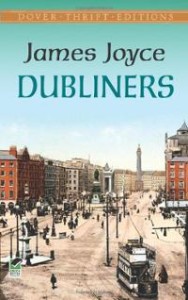A Good Place to Meet Joyce
 Joyce, James. (1914) Dubliners. New York: Dover.
Joyce, James. (1914) Dubliners. New York: Dover.
I’ve tried twice to read Ulysses, and was defeated both times, so I thought I’d start with a simpler Joyce work, and picked up Dubliners. I can report that it’s highly readable. It’s a set of 15 stories, written between 1904 and 1907, concerning Dublin life at that time. The characters and settings are vivid and detailed, easy to imagine. For the most part they are working class people, so you see the grime and squalor of poverty and alcohol, but also you glimpse contemporaneous intellectual life from conversations about politics, religion, and music. It’s a snapshot of a time and a place.
In most of the stories, nothing much happens. Ordinary people eat, drink, dance, and talk, and that’s about it. A few stories have a genuine dramatic arc, such as “Eveline,” the story of a young girl who falls in love with a sailor who promises to take her to America. Though she longs to escape her oppressive life in Dublin, she stands fixed to the dock and cannot make herself board that ship. We understand her behavioral, if not intellectual ephiphany.
The last, greatest story, “The Dead,” is longer than the others, and is really two stories. In the first part is a grand party where we meet interesting characters from many walks of life, enjoy a richly described banquet, song and dance, drinks and speeches around a fine table. In the last few pages, a main character takes his wife home, almost at dawn, and she unexpectedly confesses to a youthful love in which the young man took his life when she left him. The husband realizes he knows nothing about her, and that probably, nobody knows anything about anyone.
The stories overall roughly track the psychological development of an archetypal person in early 20th century Dublin, from the opening story, “The Sisters,” in which a young man is perplexed by death when an old priest dies, through the camaraderie of youth, the difficulties of the working years, middle age, then maturity, ending with, in that last story, a meditation on how death renders all of life meaningless. Most of the individual stories are good, and the set taken as a whole carries worthwhile themes.
The language comes at an angle to modern American English, both because of Irish expressions and allusions, and because syntax and vocabulary evolve over a hundred and fifteen years in any language. Sometimes those changes are fun. I enjoyed expressions like, “Well, doesn’t that take the biscuit!” and, “I’ve got a crow to pluck with you.”
Writers like to study these stories for their concrete clarity and directness, but as exercises in storytelling, most of them lack any dramatic tension. They’re just snapshots of ordinary people doing and saying banal things. No nail-biters here.
